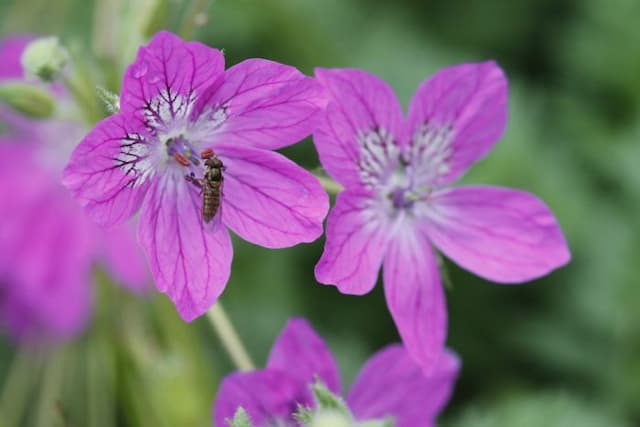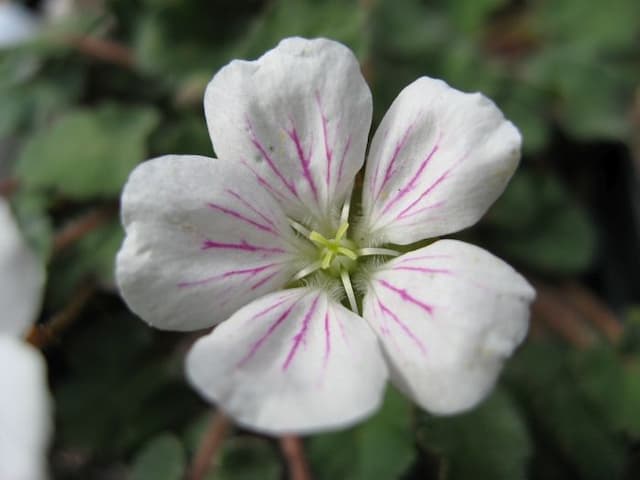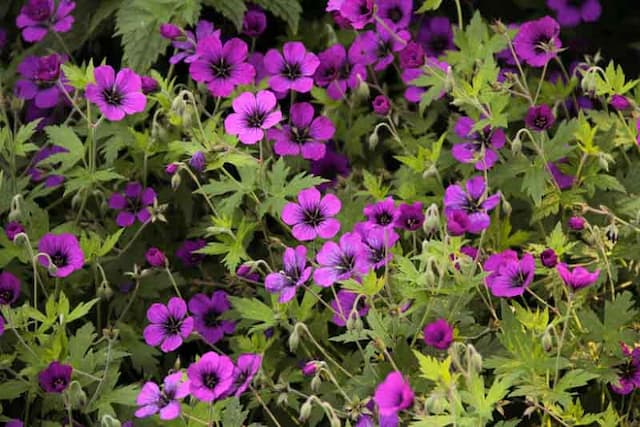Grayleaf geranium Geranium cinereum

ABOUT
The Geranium cinereum, commonly referred to as the Gray cranesbill, is noted for its compact tuft of lobed foliage, which is often gray-green in color and provides a muted backdrop to the plant's showy flowers. The leaves are deeply cut, giving them a lacy appearance that adds to the plant's overall texture. The flowers are highly decorative, showcasing five-petaled blossoms that can range in color from pale pink to violet and purple, often with attractive veining or eye-catching dark markings on the petals. Each individual flower appears to be delicately poised atop slender stems, adding a sense of lightness and grace to the plant's form. This characteristic make it a popular choice for rock gardens, borders, and as ground cover in a variety of garden settings. The blooming period is generous, spanning from late spring to early summer, and with good care, a second flush often brightens the garden in late summer or early fall, offering a prolonged display of its charming flowers.
About this plant
 Names
NamesFamily
Geraniaceae
Synonyms
Gray Cranesbill, Ashy Geranium
Common names
Geranium cinereum.
 Toxicity
ToxicityTo humans
Geraniums, including the Geranium cinereum, are generally considered non-toxic to humans. Though they are not edible and not meant for consumption, incidental ingestion typically does not result in symptoms of poisoning. There are no well-documented cases of toxicity in humans from consuming parts of this plant. However, it is always possible for individuals to have specific sensitivities or allergic reactions to plants, so it is advised to avoid ingesting plant material that is not meant to be food.
To pets
Geraniums, including the Geranium cinereum, are known to be potentially toxic to pets, particularly dogs and cats. If a pet ingests part of this plant, it may experience symptoms such as vomiting, diarrhea, depression, anorexia, and dermatitis. In most cases, the toxicity level is mild to moderate, but ingestion should be avoided, and if symptoms appear, veterinary attention should be sought.
 Characteristics
CharacteristicsLife cycle
Perennials
Foliage type
Deciduous
Color of leaves
Green
Flower color
Pink
Height
0.5 feet (15 cm)
Spread
1 feet (30 cm)
Plant type
Herb
Hardiness zones
5
Native area
Europe
Benefits
 General Benefits
General Benefits- Aesthetic Appeal: Geranium cinereum, commonly known as Gray Cranesbill, offers beautiful foliage and flowers that can enhance the visual appeal of gardens and landscapes.
- Drought Tolerance: Once established, Gray Cranesbill is quite drought-tolerant, making it a good choice for water-conserving gardens.
- Low Maintenance: This plant generally requires minimal care once established, saving time and effort for gardeners.
- Attracts Pollinators: The flowers of the Gray Cranesbill attract bees and other pollinators, promoting biodiversity in the garden.
- Ground Cover: With its spreading habit, it can serve as an effective ground cover, suppressing weeds and reducing soil erosion.
- Versatility: It can be used in a variety of garden settings, including borders, rock gardens, and containers.
- Seasonal Interest: This perennial provides seasonal interest with its blooms in late spring to early summer, and some varieties offer attractive autumn foliage coloration.
- Deer and Rabbit Resistance: Gray Cranesbill is generally resistant to grazing by deer and rabbits, which can protect other more vulnerable plants in the garden.
- Easy Propagation: It can be easily propagated by division, allowing gardeners to expand their plantings without additional cost.
- Long Blooming: Some varieties of Gray Cranesbill offer a long blooming period, extending the display of color in the garden.
 Medical Properties
Medical PropertiesThis plant is not used for medical purposes.
 Air-purifying Qualities
Air-purifying QualitiesThis plant is not specifically known for air purifying qualities.
 Other Uses
Other Uses- Geranium cinereum, commonly known as the gray cranesbill, can be used in rock gardens due to its compact size and ability to thrive in well-drained soil.
- The plant can serve as a ground-cover due to its spreading habit, helping to suppress weeds in the garden.
- Gray cranesbill's textured and often colorful foliage can provide visual interest in a container planting, especially when combined with other plants.
- The plant can attract beneficial insects such as bees and butterflies, aiding in the pollination of nearby plants.
- The dried leaves of gray cranesbill can be added to potpourris for a fresh, subtle fragrance.
- Gray cranesbill can be planted as an edging plant along walkways or borders, providing a defined outline to garden paths.
- The flowers of the plant can be used in casual floral arrangements, especially in cottage-style gardens.
- Gray cranesbill can be used in sensory gardens due to the variety of colors and textures of the leaves, which can stimulate the sense of touch.
- In areas with deer problems, gray cranesbill can be a valuable addition as it is generally deer-resistant, helping to protect more susceptible plants.
- Planting gray cranesbill near vegetables can be advantageous as it might help in reducing the damage from some common garden pests by acting as a deterrent.
Interesting Facts
 Feng Shui
Feng ShuiGeranium is not used in Feng Shui practice.
 Zodiac Sign Compitability
Zodiac Sign CompitabilityGeranium is not used in astrology practice.
 Plant Symbolism
Plant Symbolism- Unity and True Friendship: Geranium cinereum, commonly known as the Gray Cranesbill, has been said to symbolize unity and bonding, signifying a strong friendship that endures over time.
- Unexpected Meeting: Gray Cranesbill can also represent an unexpected encounter or surprise, as it can suddenly appear and thrive in unexpected places.
- Good Health: The plant is sometimes associated with good health and vitality, much like many plants that are used in traditional remedies.
 Water
WaterThe Gray Cranesbill, also known as Geranium cinereum, prefers consistent moisture but does not like to be waterlogged. It is important to water the plant deeply when the top inch of the soil feels dry to the touch. Generally, this may mean watering approximately once a week with about half a gallon for outdoor plants and less for those in pots, depending on climate conditions and pot size. During the hot and dry periods, the frequency of watering should be increased. However, it is crucial to reduce watering during the winter months when the plant is dormant.
 Light
LightGray Cranesbill thrives in full sun to partial shade conditions. The ideal spot for this plant is a location where it can receive at least six hours of sunlight daily while being protected from the harsh afternoon sun in excessively hot climates. Dappled shade can also be beneficial during the peak summer months to prevent leaf scorch.
 Temperature
TemperatureGray Cranesbill is hardy and can tolerate a broad range of temperatures. It can survive minimum temperatures down to about 0 degrees Fahrenheit but thrives best in temperate conditions. The plant's ideal growing temperatures are between 60 and 75 degrees Fahrenheit; however, it will still grow satisfactorily in temperatures reaching up to 85 degrees Fahrenheit.
 Pruning
PruningPruning Gray Cranesbill is primarily done to remove spent flowers and encourage additional blooming. Deadheading, or the process of cutting off faded flowers, can be done throughout the blooming season. More extensive pruning to shape the plant or to cut back leggy stems is best done in early spring. This helps rejuvenate the plant and promotes denser growth.
 Cleaning
CleaningNot needed
 Soil
SoilThe best soil mix for Grayleaf Geranium (Geranium cinereum) should be well-draining with a mix of loam, peat, and sand. The preferred soil pH is slightly acidic to neutral, ranging from 6.0 to 7.0.
 Repotting
RepottingGrayleaf Geranium rarely needs repotting as it is not a long-lived plant. Repot only when it outgrows its current container or every 2 to 3 years to refresh the soil.
 Humidity & Misting
Humidity & MistingGrayleaf Geranium prefers moderate humidity levels but is quite adaptable and can tolerate drier air typical of indoor environments.
 Suitable locations
Suitable locationsIndoor
Place Grayleaf Geranium in bright light inside.
Outdoor
Plant in sun or part shade with well-drained soil.
Hardiness zone
5-8 USDA
 Life cycle
Life cycleThe life of a Geranium cinereum, commonly known as the Gray Cranesbill, begins with seed germination, typically occurring in a moist, well-draining soil environment in spring. Once germinated, the seedling develops true leaves and grows into a juvenile plant, establishing a compact, mounded form. As it matures, it enters the vegetative stage, characterized by the growth of lobed, gray-green foliage and a robust root system. Upon reaching maturity, the Gray Cranesbill produces its distinctive flowers, usually pink to purple with veined petals, throughout the spring and summer months. After pollination, the flowers develop into fruit capsules that contain the seeds, resembling the bill of a crane, giving the plant its common name. At the end of the growing season, the plant may die back, especially in colder climates, but it is a perennial and will typically resprout from its rootstock the following spring.
 Propogation
PropogationPropogation time
Spring to Summer
Propogation: The Geranium cinereum, commonly known as the Grey Cranesbill, is typically propagated through seed or by division. The most popular method of propagation for Grey Cranesbill is by division, which is best done in the spring or early fall. To propagate by division, gently lift the plant from the ground with a garden fork, taking care not to damage the roots. Separate the plant into smaller clumps by either teasing the roots apart with your hands or cutting through them with a sharp knife. Each division should have a good portion of roots and several shoots. These divisions can be immediately replanted in well-draining soil, spaced about 12 inches (roughly 30 centimeters) apart to give them room to grow. Water the new plants thoroughly and keep the soil moist until they are well established.








![Cranesbill [Rothbury Gem]](/_next/image?url=https%3A%2F%2Fplants-admin.emdemapps.com%2Fimages%2Fplants%2F%2Fimages%2F604b6243984c2.png&w=640&q=75)
